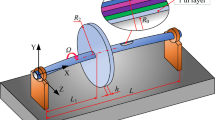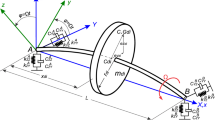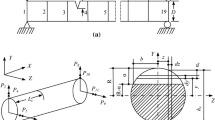Abstract
The purpose of this paper is to investigate coupling vibration characteristics of the flexible functionally graded material (FGM) shaft-disk coupling system with variable thickness disk. The mathematical model of the shaft-disk system is based on the first-order shear deformation theory, combined with the Voigt model and the four-parameter power-law distribution. The energy expression is discretized by the differential quadrature finite element method, and furthermore the differential equation of the shaft-disk system is derived. In order to verify the convergence and calculation accuracy of the current model, a series of numerical examples are introduced. In addition, the influence of geometrical and material parameters on vibration results is discussed, while the boundary conditions and the cross-sectional shape of the disk are considered. It can be seen that the variation of the FGM parameters will affect the vibration characteristics within a certain range, while the frequency parameter with different disk cross-sectional shapes is different in sensitivity to parameter changes. The parametric analysis can provide reference for the determination of structure and material parameters.
Graphic abstract















Similar content being viewed by others
References
C. Sun, Y. Chen, L. Hou, Steady-state response characteristics of a dual-rotor system induced by rub-impact. Nonlinear Dyn. 86(1), 91–105 (2016)
S.-B. Chun, C.-W. Lee, Vibration analysis of shaft-bladed disk system by using substructure synthesis and assumed modes method. J. Sound Vib. 189(5), 587–608 (1996)
Q. Han, F. Chu, Dynamic behaviors of a geared rotor system under time-periodic base angular motions. Mech. Mach. Theory 78, 1–14 (2014)
S. Chen, J. Tang, Y. Li et al., Rotordynamics analysis of a double-helical gear transmission system. Meccanica 51(1), 251–268 (2016)
F. Tornabene, E. Viola, D.J. Inman, 2-D differential quadrature solution for vibration analysis of functionally graded conical, cylindrical shell and annul plate structures. J. Sound Vib. 328, 259–290 (2009)
S.H. Hosseini-Hashemi, M. Es’haghi, M. Karimi, Closed-form vibration analysis of thick annular functionally graded plates with integrated piezoelectric layers. Int. J. Mech. Sci. 52, 410–428 (2010)
J.H. Kang, A.W. Leissa, Three-dimensional vibrations of thick, linearly tapered, annular plates. J. Sound Vib. 217, 927–944 (1998)
J.H. Kang, Three-dimensional vibration analysis of thick, circular and annular plates with nonlinear thickness variation. Comput. Struct. 81, 1663–1675 (2003)
T.U. Wu, G.R. Liu, Free vibration analysis of circular plates with variable thickness by the generalized differential quadrature rule. Int. J. Solids Struct. 38, 7967–7980 (2001)
W.H. Duan, S.T. Quek, Q. Wang, Generalized hypergeometric function solutions for transverse vibration of a class of non-uniform annular plates. J. Sound Vib. 287, 785–807 (2005)
E. Efraim, M. Eisenberger, Exact vibration analysis of variable thickness thick annular isotropic and FGM plates. J. Sound Vib. 29, 720–738 (2007)
R.L. Eshelman, R.A. Eubanks, On the critical speeds of a continuous shaft-disk system. J. Eng. Ind. 89(4), 645–652 (1967)
H.N. Özgüven, On the critical speed of a continuous shaft-disk systems. J. Vib. Acoust. Stress Reliab. Des. 106(1), 59–61 (1984)
H.S. Jia, On the bending coupled natural frequencies of a spinning, multispan Timoshenko shaft carrying elastic disks. J. Sound Vib. 221(4), 623–649 (1999)
A.A.S. Shahab, J. Thomas, Coupling effects of disc flexibility on the dynamic behaviour of multi disc-shaft systems. J. Sound Vib. 114(3), 435–452 (1987)
N. Khader, A. Atoum, A. Al-Qaisia, Theoretical and experimental modal analysis of multiple flexible disk-flexible shaft system, in SEM Annual Conference (Springfield, 2007), p. 3–6
S.T. Zhou, Y.J. Chiu, G.F. Yu et al., An assumed mode method and finite element method investigation of the coupled vibration in a flexible-disk rotor system with lacing wires. J. Mech. Sci. Technol. 31, 577–586 (2017)
H. She, C. Li, Q. Tang et al., The investigation of the coupled vibration in a flexible-disk blades system considering the influence of shaft bending vibration. Mech. Syst. Signal Process. 111, 545–569 (2018)
C. Li, H. She, Q. Tang et al., The coupling vibration characteristics of a flexible shaft-disk-blades system with mistuned features. Appl. Math. Model. 67, 557–572 (2019)
A. Entezari, M. Filippi, E. Carrera, On dynamic analysis of variable thickness disks and complex rotors subjected to thermal and mechanical prestresses. J. Sound Vib. 405, 68–85 (2017)
D.S. Kumar, C. Sujatha, N. Ganesan, Disc flexibility effects in rotor bearing systems. Comput. Struct. 62, 715–719 (1997)
H. Heydari, A. Khorram, Effects of location and aspect ratio of a flexible disk on natural frequencies and critical speeds of a rotating shaft-disk system. Int. J. Mech. Sci. 152, 596–612 (2019)
N. Fantuzzi, New insights into the strong formulation finite element method for solving elastostatic and elastodynamic problems. Curv. Layer. Struct. 1, 93–126 (2014)
R. Dimitri, N. Fantuzzi, F. Tornabene, G. Zavarise, Innovative numerical methods based on SFEM and IGA for computing stress concentrations in isotropic plates with discontinuities. Int. J. Mech. Sci. 118, 166–187 (2016)
X.-J. Yang, A new integral transform with an application in heat-transfer problem. Therm. Sci. 20, 677–681 (2016)
X.-J. Yang, New integral transforms for solving a steady heat transfer problem. Therm. Sci. 21, 79–87 (2017)
X.-J. Yang, A new integral transform operator for solving the heat-diffusion problem. Therm. Sci. 20, 639–642 (2017)
X.-J. Yang, A new integral transform operator for solving the heat-diffusion problem. Appl. Math. Lett. 64, 193–197 (2017)
X.-J. Yang, New insight into the Fourier-like and Darcy-like models in porous medium. Therm. Sci. 24, 3847–3858 (2020)
E. Viola, M. Miniaci, N. Fantuzzi, A. Marzani, Vibration analysis of multi-stepped and multi-damaged parabolic arches using GDQ. Curv. Layer. Struct. 2, 28–49 (2015)
E. Viola, F. Tornabene, E. Ferretti et al., Soft core plane state structures under static loads using GDQFEM and cell method. Comput. Model. Eng. Sci. 94, 301–329 (2013)
F. Tornabene, E. Viola, Free vibration of four-parameter functionally graded parabolic panels and shells of revolution. Eur. J. Mech. A Solids 28, 991–1013 (2009)
F. Tornabene, Free vibration analysis of functionally graded conical, cylindrical shell and annular plate structures with a four-parameter power-law distribution. Comput. Methods Appl. Mech. Eng. 198, 2911–2935 (2009)
Acknowledgements
The authors gratefully acknowledge the financial support from the National Natural Science Foundation of China (Grant No. 52075554) and Key Laboratory of Vibration and Control of Aero-Propulsion System, Ministry of Education, Northeastern University (VCAME202006).
Author information
Authors and Affiliations
Corresponding author
Appendix A
Appendix A
Differential quadrature is based on the numerical analysis method to transform the differential equation describing the boundary value problem into a set of algebraic equations in order to achieve the purpose of rapid solution.
For one-dimensional problems, let the one-dimensional function f(x) of the independent variable x be continuous and differentiable on the interval [− 1, 1]. Taking N different nodes in the interval, the first derivative of the function in xi can be expressed as:
where A(1) is a first-order weighting coefficient matrix with dimension N × N composed of first-order weighting coefficients A(1) ij, i, j = 1, 2, …, N, the superscript “(1)” indicates that the function takes the first derivative, and f is the unit displacement column vector. In this paper, Lagrange polynomials are used as the interpolation basis functions, and the elements of matrix A(1) in Eq. (A.1) can be expressed as
Similar to the differential processing, the nodes are divided in the integration interval of [− 1, 1], and then the function is integrated by the numerical integration method:
in which C is an element in the matrix of integral weight coefficients and f is a column vector of unit displacement. The weight coefficient can be solved by the Gauss quadrature method:
where Pn(ξj), j = 1, 2, …, n − 1, are Legendre polynomials of order n and Pn−1(ξj) is the (j − 1)th zero of the first derivative.
In order to adapt to the solution of different length shaft elements, the weight coefficient matrix is modified:
where Le S indicates the length of the shaft unit.
For two-dimensional problems, a two-dimensional function g(x, y), whose independent variables are x, y and their value range is [− 1, 1], is supposed. M and N nodes in the x and y directions are divided, respectively, and the first derivative of the function with respect to x and y at node (xi, yj) is
in which the matrix A(1) 02 is the weight coefficient matrix in Eq. (A.6) and matrix B(1) ij is the diagonal matrix shown in the equation.
Similarly, the two-dimensional integral weight coefficient matrix can be expressed as follows:
It is worth noting that these matrices are obtained when the interval between x and y is [− 1, 1], so the solution range needs to be transformed in practical applications.
Rights and permissions
About this article
Cite this article
Wang, R., Wang, Q., Guan, X. et al. Coupled free vibration analysis of functionally graded shaft-disk system by differential quadrature finite element method. Eur. Phys. J. Plus 136, 147 (2021). https://doi.org/10.1140/epjp/s13360-021-01131-6
Received:
Accepted:
Published:
DOI: https://doi.org/10.1140/epjp/s13360-021-01131-6




